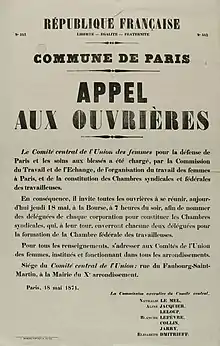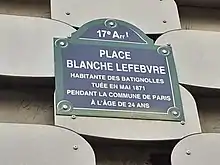Blanche Lefebvre (or Lefevre) (1847 - 23 May 1871) was a communard active in the Batignolles quarter in the 17th arrondissement of Paris. She died defending the Paris Commune during "bloody week".

Biography
Blanche Lefebvre was a laundress at the Sainte-Marie des Batignolles laundry. She lived at 34, rue des Maris, in the 10th arrondissement.[1]
During the Paris Commune, she was a member of the Club de la Révolution sociale, which was founded on 3 May 1871 in the church of Sainte-Marie des Batignolles;[1] her husband was the secretary.[2] She was also a member of the executive committee of the Union des femmes pour la défense de Paris et les soins aux blessés ("Women's Union for the Defence of Paris and the Care of the Wounded").[3] She was known to always wear a red sash and carry a revolver.[1]
Abbot Paul Fontoulieu, a strongly anti-communard but otherwise generally reliable contemporary,[4] described Lefebvre as the "queen" of the podium at the Batignolles - and as a "terrible woman", a "fanatic" who "loved the insurrection as others love a man,"[5] capable of making any sacrifice for the Commune. He compared her to Théroigne de Méricourt and Charlotte Corday (not, in his opinion, a flattering comparison), and related a story in which she shot dead a Fédéré captain on 22 May for his cowardice in the face of the Commune's looming defeat.[6]
Lefebvre was one of the women who participated in the defence of Place Blanche on 23 May 1871, along with Élisabeth Dmitrieff, Nathalie Lemel, Malvina Poulain, and Julia Béatrix Euvrie.[7] She was killed fighting Versailles troops later that day, on the rue des Dames in the 17th arrondissement,[2] on the Batignolles barricade.[8]
Legacy

A square was created in 2012 with the provisional designation "BY/17". In June 2013, Paris city hall named it "Place Blanche Lefebvre".[8]
Further reading
References
- 1 2 3 Rey, Claudine; Gayat, Annie; Pepino, Sylvie (2013). Petit dictionnaire des femmes de la Commune: Les oubliées de l'histoire (in French). Éditions Le bruit des autres. p. 173.
- 1 2 "LEFEBVRE Blanche (ou LEFÈVRE ?)". Le Maitron (in French). Paris: Maitron/Editions de l'Atelier. August 6, 2021. Archived from the original on January 21, 2022. Retrieved January 21, 2022.
- ↑ "Commune de Paris. Affiche. Appel aux ouvrières. 18 mai 1871. N° 342". bibliotheques-specialisees.paris.fr. Archived from the original on 7 January 2018. Retrieved 20 January 2022.
- ↑ Johnson, Martin Philip (1994). "Citizenship and gender: the légion des Fédérées in the Paris Commune of 1871". French History. 8 (3): 287. doi:10.1093/fh/8.3.276.
- ↑ "Il y eut néanmoins une reine de la tribune, et cette reine fut une blanchisseuse du lavoir Sainte-Marie, rue Legendre. [...] Une terrible femme que cette blanchisseuse! fanatique de la Commune, enivrée par la guerre civile, aimant l'insurrection comme d'autres aiment un homme [...]"
- ↑ Fontoulieu, Paul (1873). Les Églises de Paris sous la Commune (in French). Édouard Dentu. pp. 224–226.
- ↑ "Communication de Marie Guermont au colloque Republique Commune de novembre 2011" (PDF). federations.fnlp.fr. Archived (PDF) from the original on 16 May 2017. Retrieved 20 January 2022.
- 1 2 Le Maire de Paris (2013). "Attribution à une place de la dénomination " place Blanche Lefebvre "" (in French). Archived from the original on March 3, 2016. Retrieved January 20, 2022.